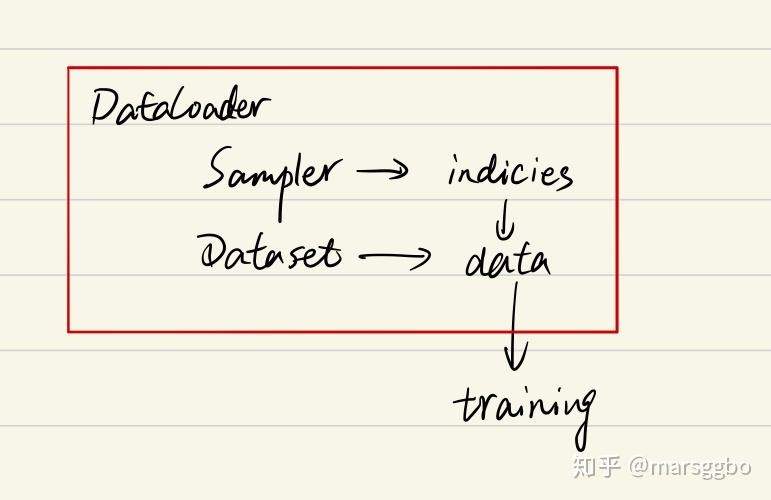利用pytorch自定义CNN网络(二):数据集的准备
本文是利用pytorch自定义CNN网络系列的第二篇,主要介绍构建网络前数据集的准备,关于本系列的全文见这里。
笔者的运行环境:CPU (AMD Ryzen™ 5 4600U) + pytorch (1.13,CPU版) + jupyter;
本文所用到的资源:链接:https://pan.baidu.com/s/1WgW3IK40Xf_Zci7D_BVLRg 提取码:1212
在训练网络模型时,我们可以使用torchvision库自带的数据集(torchvision.datasets),也可以使用自己的数据集。实际运用中一般都是使用自己的数据集,本文就讲一下该如何准备自己的数据。这里呢,笔者偷了个懒,我使用的是下载好的FashionMNIST数据集,刚好这里也讲一下如何将.ubyte文件转换为.jpg文件。
1. 一个例子
首先来看一个例子:
import os
import cv2
import torchvision.datasets.mnist as mnist
root="D:\\Users\\CV learning\\pytorch\\FashionMNIST\\raw\\"
# 读取训练图像和对应标签,并将其转换为Tensor类型
train_set=(mnist.read_image_file(root+"train-images-idx3-ubyte"),
mnist.read_label_file(root+"train-labels-idx1-ubyte"))
# 读取测试图像和对应标签,并将其转换为Tensor类型
test_set=(mnist.read_image_file(root+"t10k-images-idx3-ubyte"),
mnist.read_label_file(root+"t10k-labels-idx1-ubyte"))
# 输出训练数据和测试数据的相关信息
print("训练图像数据集的有关信息---",train_set[0].size())
print("测试图像数据集的有关信息---",test_set[0].size())
#定义一个函数将数据集转换为图像
def convert_to_img(train=True):
if train:
f = open(root+"train.txt", "w")
data_path = root+"train\\"
#判断是否存在data_path文件夹,若不存在则创建一个
if not os.path.exists(data_path):
os.makedirs(data_path)
#将image、label组合成带有序列的迭代器,并遍历;保存图像,并保存图像地址和标签在.txt中
for i, (img, label) in enumerate(zip(train_set[0], train_set[1])):
img_path = data_path+str(i)+".jpg"
cv2.imwrite(img_path, img.numpy())
f.write(img_path+'---'+str(int(label))+'\n')
f.close()
else:
f = open(root+"test.txt", "w")
data_path = root+"test\\"
#判断是否存在data_path文件夹,若不存在则创建一个
if not os.path.exists(data_path):
os.makedirs(data_path)
#将image、label组合成带有序列的迭代器,并遍历;保存图像,并保存图像地址和标签在.txt中
for i, (img, label) in enumerate(zip(test_set[0], test_set[1])):
img_path = data_path+str(i)+'.jpg'
cv2.imwrite(img_path, img.numpy())
f.write(img_path+'---'+str(int(label))+'\n')
f.close()
convert_to_img(True)
convert_to_img(False)
import torch
import cv2
from torchvision import transforms
from torch.utils.data import Dataset, DataLoader
root = "D:\\Users\\CV learning\\pytorch\\FashionMNIST\\raw\\"
class MyDataset(Dataset):
def __init__(self, txt, transform = None):
with open(txt, 'r') as ft:
imgs = []
for line in ft:
line = line.strip('\n')
words = line.split('---')
imgs.append((words[0], int(words[1])))
self.imgs = imgs
self.transform = transform
def __getitem__(self, index):
fn, label = self.imgs[index]
img = cv2.imread(fn, cv2.IMREAD_COLOR)
if self.transform is not None:
img = self.transform(img)
return img, label
def __len__(self):
return len(self.imgs)
train_data = MyDataset(root+'train.txt', transform=transforms.ToTensor())
test_data= MyDataset(root+'test.txt', transform=transforms.ToTensor())
train_loader = DataLoader(dataset=train_data, batch_size=64, shuffle=True)
test_loader = DataLoader(dataset=test_data, batch_size=64)
运行结果:

从上面的例子可以看出,数据集的准备就是将不适用于pytorch的数据转换为适用的数据类型,即Tensor;当训练样本数量太过庞大时,需要分成多个Batch来训练,因此就需要设置batch_size的大小。上个例子中的数据并没有在GPU中建立副本,通常为了充分调用GPU,还需要设置一些如num_workers、pin_memory等参数。
具体而言,数据集的准备与torch.utils.data模块下DataSet、DataLoader和Sampler类有关,下面让我们来看看这三个类之间的关系。
2. DataSet、DataLoader和Sampler
一文弄懂Pytorch的DataLoader, DataSet, Sampler之间的关系,这篇文章讲简单易懂,因此就直接拿来用了。
2.1. 自上而下理解三者关系
首先我们看一下DataLoader.next的源代码长什么样,为方便理解我只选取了num_works为0的情况(num_works简单理解就是能够并行化地读取数据)。
class DataLoader(object):
...
def __next__(self):
if self.num_workers == 0:
indices = next(self.sample_iter) # Sampler
batch = self.collate_fn([self.dataset[i] for i in indices]) # Dataset
if self.pin_memory:
batch = _utils.pin_memory.pin_memory_batch(batch)
return batch
在阅读上面代码前,我们可以假设我们的数据是一组图像,每一张图像对应一个index,那么如果我们要读取数据就只需要对应的index即可,即上面代码中的indices,而选取index的方式有多种,有按顺序的,也有乱序的,所以这个工作需要Sampler完成,现在你不需要具体的细节,后面会介绍,你只需要知道DataLoader和Sampler在这里产生关系。
那么Dataset和DataLoader在什么时候产生关系呢?没错就是下面一行。我们已经拿到了indices,那么下一步我们只需要根据index对数据进行读取即可了。
再下面的if语句的作用简单理解就是,如果pin_memory=True,那么Pytorch会采取一系列操作把数据拷贝到GPU,总之就是为了加速。
综上可以知道DataLoader,Sampler和Dataset三者关系如下:
在阅读后文的过程中,你始终需要将上面的关系记在心里,这样能帮助你更好地理解。
2.2. Sampler
参数传递
要更加细致地理解Sampler原理,我们需要先阅读一下DataLoader 的源代码,如下:
class DataLoader(object):
def __init__(self, dataset, batch_size=1, shuffle=False, sampler=None,
batch_sampler=None, num_workers=0, collate_fn=default_collate,
pin_memory=False, drop_last=False, timeout=0,
worker_init_fn=None)
可以看到初始化参数里有两种sampler:sampler和batch_sampler,都默认为None。前者的作用是生成一系列的index,而batch_sampler则是将sampler生成的indices打包分组,得到一个又一个batch的index。例如下面示例中,BatchSampler将SequentialSampler生成的index按照指定的batch size分组。
>>>in : list(BatchSampler(SequentialSampler(range(10)), batch_size=3, drop_last=False))
>>>out: [[0, 1, 2], [3, 4, 5], [6, 7, 8], [9]]
Pytorch中已经实现的Sampler有如下几种:
SequentialSamplerRandomSamplerWeightedSamplerSubsetRandomSampler
需要注意的是DataLoader的部分初始化参数之间存在互斥关系,这个你可以通过阅读源码更深地理解,这里只做总结:
- 如果你自定义了
batch_sampler那么这些参数都必须使用默认值:batch_size,shuffle,sampler,drop_last. - 如果你自定义了
sampler,那么shuffle需要设置为False - 如果
sampler和batch_sampler都为None,那么batch_sampler使用Pytorch已经实现好的BatchSampler,而sampler分两种情况:
2.3. 如何自定义Sampler和BatchSampler?
仔细查看源代码其实可以发现,所有采样器其实都继承自同一个父类,即Sampler,其代码定义如下:
class Sampler(object):
r"""Base class for all Samplers.
Every Sampler subclass has to provide an :meth:`__iter__` method, providing a
way to iterate over indices of dataset elements, and a :meth:`__len__` method
that returns the length of the returned iterators.
.. note:: The :meth:`__len__` method isn't strictly required by
:class:`~torch.utils.data.DataLoader`, but is expected in any
calculation involving the length of a :class:`~torch.utils.data.DataLoader`.
"""
def __init__(self, data_source):
pass
def __iter__(self):
raise NotImplementedError
def __len__(self):
return len(self.data_source)
所以你要做的就是定义好__iter__(self)函数,不过要注意的是该函数的返回值需要是可迭代的。例如SequentialSampler返回的是iter(range(len(self.data_source)))。
另外BatchSampler与其他Sampler的主要区别是它需要将Sampler作为参数进行打包,进而每次迭代返回以batch size为大小的index列表。也就是说在后面的读取数据过程中使用的都是batch sampler。
2.4. Dataset
Dataset定义方式如下:
class Dataset(object):
def __init__(self):
...
def __getitem__(self, index):
return ...
def __len__(self):
return ...
上面三个方法是最基本的,其中__getitem__是最主要的方法,它规定了如何读取数据。但是它又不同于一般的方法,因为它是python built-in方法,其主要作用是能让该类可以像list一样通过索引值对数据进行访问。假如你定义好了一个dataset,那么你可以直接通过dataset[0]来访问第一个数据。在此之前我一直没弄清楚__getitem__是什么作用,所以一直不知道该怎么进入到这个函数进行调试。现在如果你想对__getitem__方法进行调试,你可以写一个for循环遍历dataset来进行调试了,而不用构建dataloader等一大堆东西了,建议学会使用ipdb这个库,非常实用!!!以后有时间再写一篇ipdb的使用教程。另外,其实我们通过最前面的Dataloader的__next__函数可以看到DataLoader对数据的读取其实就是用了for循环来遍历数据,不用往上翻了,我直接复制了一遍,如下:
class DataLoader(object):
...
def __next__(self):
if self.num_workers == 0:
indices = next(self.sample_iter)
batch = self.collate_fn([self.dataset[i] for i in indices]) # this line
if self.pin_memory:
batch = _utils.pin_memory.pin_memory_batch(batch)
return batch
我们仔细看可以发现,前面还有一个self.collate_fn方法,这个是干嘛用的呢?在介绍前我们需要知道每个参数的意义:
indices: 表示每一个iteration,sampler返回的indices,即一个batch size大小的索引列表self.dataset[i]: 前面已经介绍了,这里就是对第i个数据进行读取操作,一般来说self.dataset[i]=(img, label)
看到这不难猜出collate_fn的作用就是将一个batch的数据进行合并操作。默认的collate_fn是将img和label分别合并成imgs和labels,所以如果你的__getitem__方法只是返回 img, label,那么你可以使用默认的collate_fn方法,但是如果你每次读取的数据有img, box, label等等,那么你就需要自定义collate_fn来将对应的数据合并成一个batch数据,这样方便后续的训练步骤。
如果大家对这三个类的源码感兴趣可以阅读这篇文章:PyTorch源码解析与实践(1):数据加载Dataset,Sampler与DataLoader

